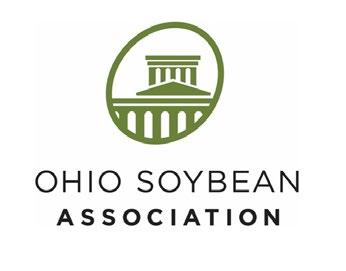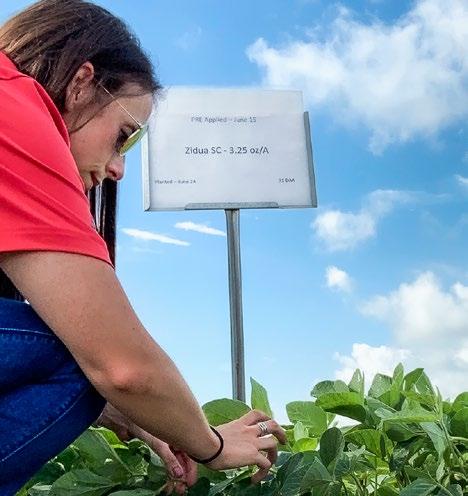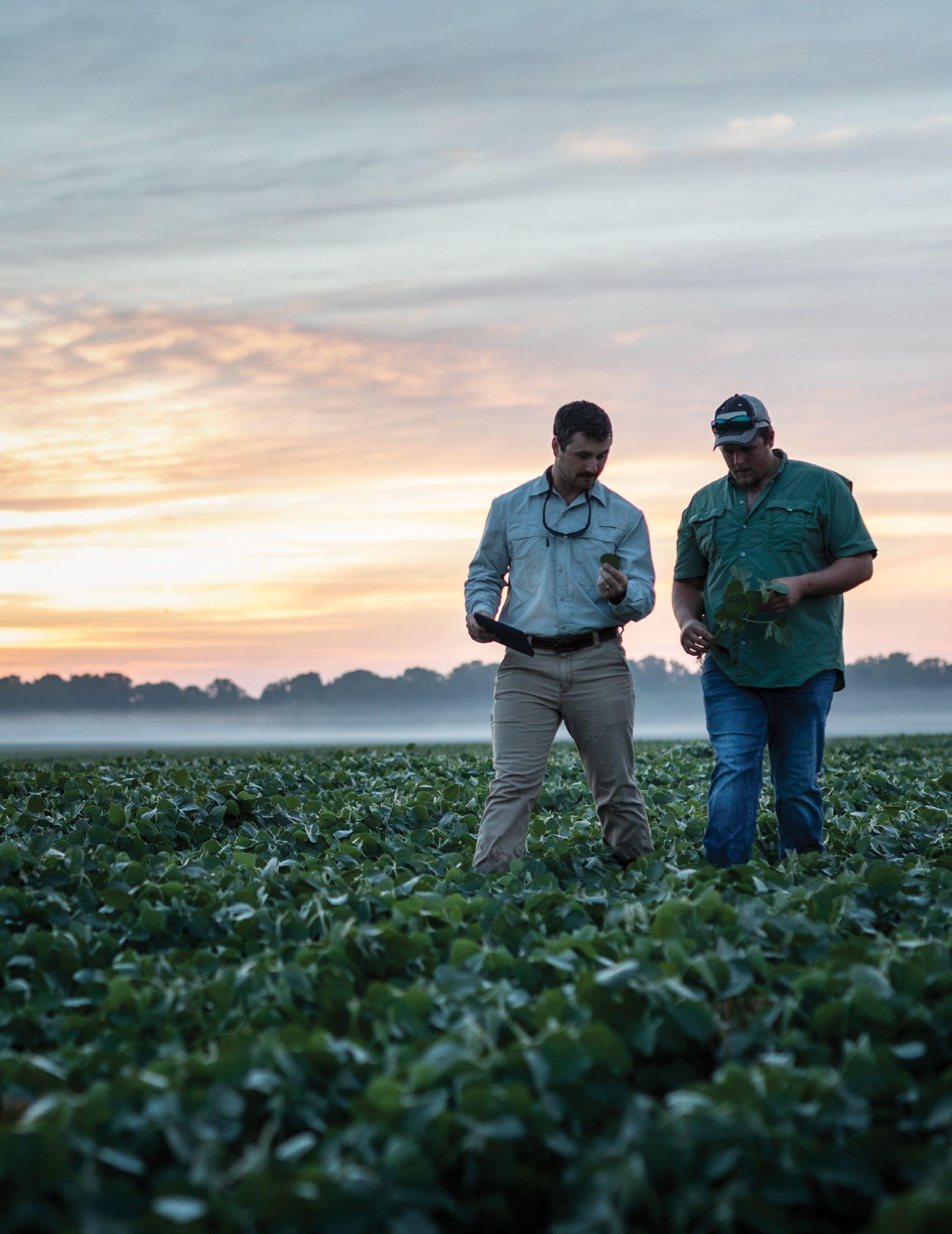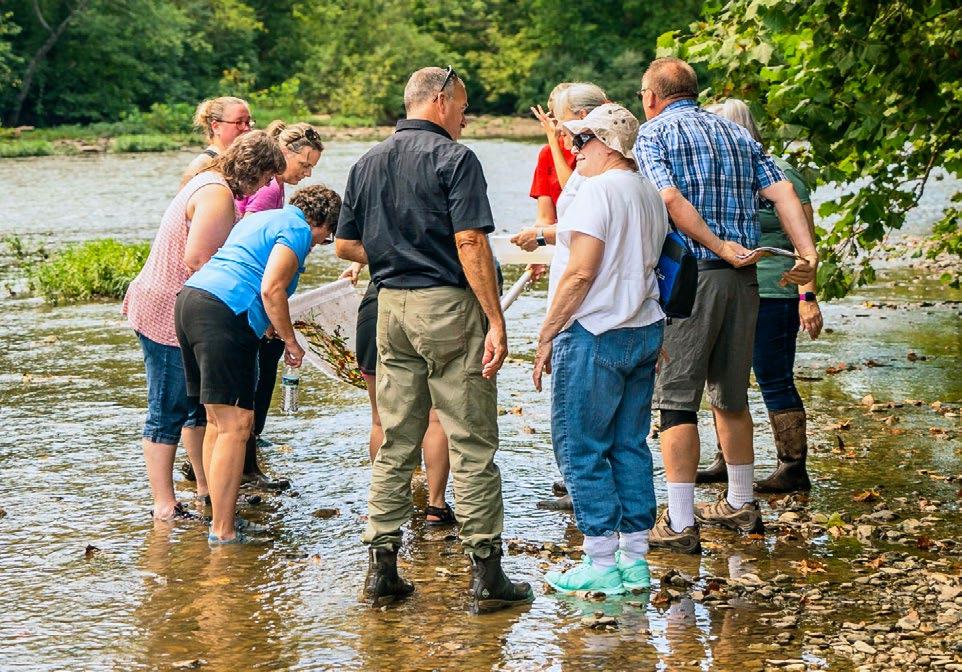
OSA Thanks Corporate Partners p. 8 OSCF Scholarship Applications Now Open p. 11



OSA Thanks Corporate Partners p. 8 OSCF Scholarship Applications Now Open p. 11

From researching new uses for soybeans to identifying new markets for U.S. soy, the soy checkoff is working behind the scenes to create new opportunities and increase profits for soybean farmers. We’re looking inside the bean, beyond the bushel and around the world to keep preference for U.S. soy strong. And it’s helping make a valuable impact for soybean farmers like you.
See more ways the soy checkoff is maximizing profit opportunities for soybean farmers at unitedsoybean.org




Patrick Knouff
Ohio Soybean Association President Shelby County soybean farmer
Much like farmers, the Ohio Soybean Association’s (OSA) work is never really done. There are always new things on our horizon and that’s what makes it such an exciting organization to lead. As our combines are being stored away and fall turns into winter, OSA has some exciting things coming down the pipeline for our members.
First, I want to thank the participants and sponsors of our annual Harvest Classic golf outing, which took place at the beginning of September. This outing helps to fund the important work OSA does on behalf of the soybean industry, much of which would not be possible without the help of our sponsors. Every year I am overwhelmed with the generosity and enthusiasm of our partners and it just goes to show what a tight-knit community Ohio agriculture is.
Another annual OSA event is quickly approaching — the 2022 Ohio Grain Farmers Symposium! This event, which takes place in partnership with the Ohio Corn and Wheat Growers Association, brings together the experts in our field for a day of learning and networking. We welcome you to join us on December 2 at the Nationwide & Ohio Farm Bureau 4-H Center. I have gotten to peek at the agenda and I know that the event is full of interesting and important information for farmers. Find more information and register at www.ohiograinfarmerssymposium.org.
Lastly, I wanted to bring to your attention several scholarship opportunities for college students. OSA will be offering one $1,000 scholarship to students of any major with a passion for the soybean industry. The scholarship will be applied the 2023–2024 school year. All majors are eligible, but applicants must show a strong interest in the soybean industry and agricultural advocacy. Applicants must be enrolled as a full-time student at a college, university or technical school and have a 3.0 GPA or higher. Applicants must also be immediate family (child or grandchild) of a current OSA member OR a Student or Young Adult Member (SYA) of the Ohio Soybean Association (SYA membership is free). Applications are due by January 13, 2023 at 11:59 p.m. and can be found at https://forms.gle/7hciQU27fPy11GB78 For more information on OSA’s scholarship contact Emilie Regula Hancock at eregula.hancock@soyohio.org
The Ohio Soybean Council Foundation also has $64,000 in scholarships available to both undergraduate and graduate students this year. Applications for these scholarships are also due by January 13, 2023 at 11:59 p.m. Further details about the 14 scholarships are available on page 11 or by visiting www.soyohio.org/scholarships
Wishing you and your family a safe and happy holiday season!
Patrick Knouff
President
Patrick Knouff, Shelby County
Vice President
Rusty Goebel, Williams County
Treasurer
Jerry Bambauer, Auglaize County
Secretary
Trish Cunningham, Union County
Chairman
Ryan Rhoades, Marion County
Trustees
David Clark, Warren County
Justin Esselburn, Holmes County
Austin Heil, Hardin County
Caitlyn Heimerl, Industry Affiliate Ex-Officio
Jeff Magyar, Ashtabula County
Jeff McKanna, Hancock County
Bennett Musselman, Pickaway County
Derek Reusser, Holmes County
Andy Stickel, Wood County
Bob Suver, Clark County
Kerrick Wilson, Preble County
American Soybean Association
Board Representatives
Jerry Bambauer
Scott Metzger
Ryan Rhoades
Staff Credits
Kirk Merritt - Publisher
Julia Brown - Editor
Madi Layman - Staff Writer
Brent Warren - Art Director
Barry Falkner - Photo Quality/Proofer
Ohio Soybean news is published six times a year by the Ohio Soybean Association, 918 Proprietors Rd., Suite A, Worthington, OH 43085. Phone: 614-476-3100.
Comments and statewide news articles should be sent to the above address. Advertising space reservation must be made by the first of the month preceding publication. In consideration of the acceptance of advertisement, the agency and the advertiser must, in respect of the contents of the advertisement, indemnify and save the publisher harmless against any expense arising from claims or actions against the publisher because of the publication of the content of the advertisement.
For Advertising Sales Contact: Matt Herman - (612) 812-5833 matt.herman@dtn.com
For Address Corrections Contact: Ohio Soybean News at 918 Proprietors Rd., Suite A, Worthington, OH 43085.
Web address: www.soyohio.org E-mail: cdeboard@soyohio.org


In 2019, Governor Mike DeWine launched the H2Ohio program, which is a comprehensive water quality initiative. The program’s goal is to strategically address
serious water issues that have been building in Ohio for decades. It focuses on producers in all 24 counties of the Western Lake Erie Basin (WLEB), and since the

Completed Best Management Practices, Maumee River Basin – 2021

The statistics are up to date as of July 1, 2022. Practices in each countywillcontinuetobeverifiedthrough2022sothenumbersare expectedtogrowbytheendoftheyear.
Source: H2Ohio Annual Report
launch three years ago, 1.2 million acres of cropland have been enrolled into agriculture best management practices. The program has seen tremendous participation, and its success is shown through the commitment of producers and their continued enrollment.
Legislators in the Ohio General Assembly have supported the program, allocating $120 million for the Ohio Department of Agriculture’s (ODA) H2Ohio producer incentive program in FY 2022 and FY 2023. ODA also received federal funding through the Great Lakes Restoration Initiative. What does this mean for you? We hope that H2Ohio continues to grow and expand to all producers in the state, so that every soybean farmer has the opportunity to use H2Ohio funds and participate in best management practices and voluntary nutrient management practices. The Ohio Soybean Association will continue to advocate for an H2Ohio that benefits farmers, now and in the future. u

Your revolutionized soybean delivery experience is here. We have invested in state-of-the-art technology aimed at expanding your marketing opportunities and streamlining your time at our plants.
Contact your Cargill rep for more information. Now in Bloomingburg: Unload speed 2X quicker New drying capacity
Coming to Sidney in 2023: Expanded crush capacity Dramatically quicker unloads



















In August 2022, the U.S. Soybean Export Council (USSEC) welcomed international buyers and users of soy to the United States for Soy Connext — the global U.S. Soy summit, held in San Diego, California. More than 60 countries were represented, and the conference welcomed over 600 attendees.


“We’re so glad to have had the opportunity to come together in person to strengthen relationships with U.S. Soy’s international customers and industry partners,” said Jim Sutter, USSEC chief executive officer. “During this year’s forum we heard three recurring themes — we’re in transformative and volatile times, supply chains continue to face challenges and consumers are calling for reduced carbon footprints and increased transparency. Soy Connext provides an excellent forum to collaborate so companies can leverage U.S. Soy’s superior quality, reliability and sustainability in response to these challenges.”
Soybean farmers Bill Bayliss of Logan County, Steve Reinhard of Crawford County and staff member Madi Layman represented the Ohio Soybean Council (OSC) at the event.
“The relationships built at events like these are very beneficial to the future of the soybean industry,” said Bill Bayliss, OSC Vice Chairman. “Soy Connext showcased the quality crop grown in the U.S. and its
numerous benefits to different regions around the globe. We got the chance to connect with buyers and other industry experts to learn about what we as farmers can be doing to increase the preference for U.S. Soy.”
The agenda covered top-of-mind issues for those who work in the food and agriculture sector, with sessions on macro-economic trends, the shifting vegetable oil complex, freight and logistics, and specialty soybeans for soy foods. And the important topic of sustainability was embedded throughout the program.
Also in August, 11 soy industry leaders from Korea visited OSC board member Scott Metzger’s farm in Ross County. Metzger talked about his operation, U.S. Soy, sustainable practices, GMO and food-grade beans, government subsidies and his various leadership roles in the soybean industry.
“It’s one thing talking about soybean production, it’s another to see it in the works,” Metzger said.
“They had a chance to go out into one of our fields. They also asked important questions and I got the chance to pick their brains on what international buyers are looking for in bean quality. All in all, these visits benefit both the buyers and the producers.”
This team also toured CGB’s facility in Cincinnati, Rogers Grain in Covington and Bluegrass Farms in Jeffersonville.
Additionally, Trumbull County farmer Dan Schwartz and OSC Chairman Jeff Magyar of Ashtabula County hosted a Japan Tofu Future Team at Schwartz Farms in Northeast Ohio. The team consisted of 11 soy industry leaders from Japan. The team also visited the McHale Research Lab at The Ohio State University and heard about soybean breeding from Leah McHale and Alex Lindsey, Bluegrass Farms and KAPI in Marysville.
These visits give international customers the opportunity to assess the quality of Ohio soybeans and talk with Ohio farmers about their buying needs. u


AVAILABLE to graduate & undergraduate students studying agriculture or a related field.

Scan the QR Code or visit SoyOhio.org/Scholarships to learn more about our program and how to apply
Undergraduate Scholarships
SEVEN $3,000 Ohio Soybean Council Foundation Scholarships
ONE $3,000 Robinson W. Joslin Scholarship
ONE $5,000 Bhima Vijayendran Scholarship
TWO $10,000 Richard Cocks Scholarships, to be distributed across three years for students who are current freshman and entering their sophomore year of college in Fall of 2023.
Graduate Scholarships
THREE $5,000 Ohio Soybean Council Foundation Scholarships
This past summer, with financial support from the Ohio Soybean Council (OSC) and Ohio soybean checkoff, GrowNextGen teacher leaders engaged in externships around the Buckeye State to give STEM teachers a taste of ag careers.
Meghan Prendergast learned about conservation from a farmer’s point of view. Prendergast, who teaches biology and plant/animal biotechnology at Global Impact STEM Academy, completed an externship at Kellogg Farms, part of the Blanchard River Demonstration Farms Network.
Prendergast toured the grounds which included stops at all of their major water quality management tactics including grass waterways, pollinator gardens, cover crops, as well as other geographical features of the area off the property.
“Bill [Kellogg] took a worldly approach to the idea of conservation,” Prendergast said. “It wasn’t just about what he could see or what he understood — he knew there was a bigger picture. With my background in marine biology, he and I frequently discussed how both of these jobs are integral to the health of the ecosystem, but are often considered distinctly different and separate realms of science.”
As a follow-up to her externship, Prendergast plans on using soil chemistry, water quality and the concepts she learned about to create a board game of choices to improve water quality over time. It would implement measures that would be seen on Kellogg Farms, as well as other water quality management practices.
GNG teacher leader Jamie Brown got a close-up look at agriculture in Ohio
this summer thanks to an externship with BASF.
Jamie, who teaches science and math at Miami East Junior High, spent her externship all over the state, from Lake Erie to Wooster to Troy.
“My biggest ‘a-ha’ was realizing how many variables growers are juggling,” she said. “I knew there were many components to farming, but I didn’t realize how many different things can be affecting plant health. Farmers not only need to think about the products they’re choosing to use in and on their fields each growing

season, but also need to consider what has been on their field in the past, as well as what they’re looking to grow in the future, their soil type, product availability, timing of application and so much more.”
From this experience, Brown will be creating a claim, evidence, reasoning exercise focused on the variables that can affect plant health and yield. This will allow students to consider the many variables that play into keeping a plant healthy and
producing high yields. “Often, the general public just sees it as the plant didn’t get enough rain or it received too much rain, while in reality so many decisions and uncontrollable variables play into the yield of a particular field.”
Another teacher leader, Chris Brown, a 7th and 8th grade science teacher at Glandorf Elementary School, also spent time on a farm. Brown worked at Stateler Farms in McComb, Ohio, where he shadowed Duane and Anthony Stateler. “I saw their hog operation, helped with equipment repair, got a comprehensive tour of the various water quality best practices they implement, and just experienced the unpredictability of farm life,” he said.
“I already knew that ‘farming’ isn’t just planting and harvesting crops, but to be able to see it and talk about it from multiple generations of farmers was something I can really take back to the classroom. A student who loves technology might not be aware of the amount of tech used in farming now from electronics in the equipment, to drones and fertilizer/ nutrient application and beyond. I can tell them about all the careers connected to agriculture.”
Brown will be creating a design challenge where students will create mini farm fields using paint trays and everyday products to create a model of one of the water quality best practices implemented at the Blanchard River Demonstration Farms, as Stateler Farms is part of this group.
If you are a teacher interested in participating in future externships or an agriculture-related business open to hosting teachers, visit GrowNextGen.org u
The U.S. Soy Sustainability Assurance Protocol (SSAP) has earned Silver Level Equivalence when benchmarked with the Sustainable Agriculture Initiative (SAI) Platform’s Farm Sustainability Assessment (FSA) 3.0. The SSAP provides verified sustainable soybean production on a national scale for U.S. soybean farmers. The benchmark eases the process for the food and beverage sector to assess, improve and validate on-farm sustainability in their supply chains with U.S. Soy.
“This designation is important for international customers of U.S. Soy and holds the potential to expand markets, especially in Europe where demand for FSA designated
soybeans is greater,” said Abby Rinne, sustainability director at USSEC.
The FSA Silver Level Equivalence designation is the latest third-party recognition of the sustainability of U.S. Soy. It joins the European Feed Manufacturers Organization (FEFAC), Global Seafood Alliance: Best Aquaculture Practices — Sustainable Feed, The Consumer Goods Forum, the Tokyo 2022 Olympics, and the UK Roundtable on Sustainable Soya, all of which have already positively benchmarked the SSAP.
“The benchmark of SSAP against the FSA recognizes the excellent sustainability efforts that the program is making with
regards to U.S. Soy. The benchmark also offers the opportunity for U.S.-based farmers to better reach international markets as the FSA is a globally accepted definition and framework of what on-farm sustainability looks like,” said Joe Iveson, FSA Manager.
The U.S. Soy differentiation is being recognized with SSAP verified exports up 33 percent compared to the same time period one year ago, and as of July 28, 2022, they make up 58 percent of total exports (approx. 64 MMT) for the current marketing year. Additionally, the Sustainable U.S. Soy label is featured on more than 850 product packs internationally. u

Don’t be afraid. Just believe. Mark 5:36

Earlier this year, the Ohio Soybean Council (OSC) hired Wendy Hovey as its new Administrative and Organizational Manager and promoted Madi Layman to Demand and Market Development Manager from her previous role as Communications Coordinator.
As Administrative and Organizational Manager, Hovey will be working on behalf of Ohio soybean farmers in supporting on-boarding, leadership and development for the board members and will help execute OSC events throughout the year. She will also act as the office’s human resources liaison.
“Wendy will be a great addition to the Ohio Soybean team,” said Kirk Merritt, OSC executive director. “She is a real go-getter. Her strong work ethic will make our office more efficient and our board stronger. We are happy to have her on board.”

Hovey has 17 years of experience in facility and administrative management. She comes to OSC from Otterbein University’s Equine Science Department where she served as facility manager from 2017–2022. She earned a Bachelor of Arts degree in psychology from Otterbein University and has years of team management, and administrative and event organization experience.
In her new role as Demand and Market Development Manager, Layman will be working on behalf of Ohio soybean farmers by increasing global market access for Ohio soybeans and increasing customer awareness of the value and preference for high quality Ohio soybeans. She will also be monitoring the biodiesel and renewable diesel markets and seek opportunities for growth in those industries in Ohio.
“Both Wendy and Madi are bringing high-level knowledge into
their new roles with the Council,” said OSC Chairman Jeff Magyar, Ashtabula County soybean farmer. “Madi has been with us a little over a year. With her soybean experience and knowledge of the industry I believe she will do a great job at growing markets and building buyer relationships for Ohio soybean farmers.”
Layman joined the OSC team in June of 2021 as Communications Coordinator. In this role, she was responsible for content creation, editorial writing and editing, event management, digital marketing and social media outreach to both farmers and consumers. She was also responsible for managing the Ohio Soybean magazine and Ohio Soybean Council Foundation scholarship program. Madi earned a Bachelor of Science in agricultural communication from The Ohio State University in May 2021. She grew up on a dairy farm in Licking County. u
As more food companies move toward regenerative agriculture commitments to meet bold sustainability goals, close collaboration between the food industry and farmers is key to ensuring true sustainability along the supply chain. That was the overarching message when soybean farmers and food companies discussed the complexities of regenerative agriculture during a September virtual roundtable meeting hosted by the United Soybean Board (USB) and The Center for Food Integrity (CFI). The meeting was part of a broader effort by USB and CFI to foster collaboration between farms and food companies on the topic of sustainability.
Farmers shared their on-farm sustainability efforts to enhance soil health and sequester carbon through practices such as no-till and cover crops, and food companies detailed their current projects and how they work with farmer suppliers. While there was no consensus on a specific definition for regenerative agriculture, all agreed it’s about continuously improving farm sustainability while protecting natural resources and farmer livelihoods.
Food companies described how they are working with farmers to reach sustainability goals. Cargill has worked across various supply chains over the years to enhance sustainability, including row crops, beef, cocoa in West Africa and palm in southeast Asia.
“What we find with regenerative agriculture is these principles around soil health and improving farmer profitability can be applied across geography and across farm size,” said Ashley McKeon,

director of regenerative agriculture at Cargill. “We see regenerative agriculture as feeding a growing population, while improving farmer profitability and having positive environmental outcomes — a triple win. We asked ourselves how our company could play a role.”
Two years ago, Cargill set a commitment to advance regenerative agriculture across 10 million acres in North America by 2030.
The good news, said McKeon, “is we’re not starting from ground zero with agriculture. Many farmers have been doing this for a long time. Our job is to help build on successes and remove some barriers that have gotten in the way of larger-scale adoption.”
It’s an approach Tony Mellenthin, Wisconsin soybean farmer and USB farmer-leader, appreciates.
“There’s no one-size-fits-all,” he said. “What works for a southern farmer may not work for a northern farmer in terms of conservation practices. But even though their approaches may look different, they’re still improving the sustainability of U.S. agriculture.”
When PepsiCo made a commitment last year to spread
regenerative agriculture across all acres from which they’re purchasing, they did so because strong and resilient agricultural communities are the basis for maintaining their own growth, as PepsiCo is on a growth trajectory.
“We know we’re going to need strong farms into the future. Our goal is to keep farmers farming and do it in a way that improves their resilience as our climate changes,” said Margaret Henry, senior director of sustainable ag strategy at PepsiCo who grew up on her family’s Kentucky dairy farm.
“Farmers are experiencing 10-year and 20-year weather events almost every year now and it’s hurting their pocketbooks directly.”
The demands at the farmgate for sustainable and regenerative practices will only continue to grow, according to Henry.
“Over the next 24 to 36 months in the food and beverage space, we’re going to see a tremendous scaling of what five years ago, we were doing this on a few thousand acres. Now we’re seeing scaled engagement all over the country reaching millions of acres and that momentum is only increasing.” u
After 25 years, the Tri-State Fertilizer Recommendations for Corn, Soybeans, Wheat, and Alfalfa guide has been comprehensively updated and is now available. This update is due in large part to funding from the Ohio Soybean Council (OSC) and soybean checkoff. The full version can be downloaded as a free pdf, or a printed copy can be purchased at: www.soyohio.org/TriState.
The recommendations are based on more than a decade of field trials evaluating N, P, K, S and micronutrients, including over 300 on-farm trials across 41 Ohio counties. This work confirms that the original Tri-State recommendations provided sound guidelines for nutrient management. However, some changes in the recommendations have been made to keep pace with contemporary practices in Ohio’s field crops. This new guide provides an objective framework for farmers to manage nutrients as judiciously and profitably as possible.
“These updated Tri-State Fertilizer Recommendations can help farmers make decisions that are best for both their farm and their bottom line,” said Jerry Bambauer, Auglaize County soybean farmer and chair of the OSC Research Committee. “Especially with input costs on the rise, these recommendations demonstrate what will get the highest yield while maintaining profitability, which is a key goal for the soybean checkoff.”
Extensive research station and on-farm trials have been conducted over the past decade to validate and refine the guidelines. In general, the fertilizer recommendations originally published in 1995 provide a solid framework for managing
fertilizers and soil fertility. However, some changes have been made to the recommendations. Soil sampling remains a critical component of effective nutrient management.
Sample soil in a consistent way every 3 to 4 years, with samples representing no more than 25-acres.
• Adapt nutrient management based on trends over time.

Soil pH remains one of the most important aspects of supplying adequate nutrition to crops.
• Soil pH should be kept between 6.0 and 6.8 for field crops.
Optimizing nitrogen management is challenging and requires careful consideration of many factors.
• Nitrogen rate recommendations for corn are based on an economic model designed to maximize farmer profitability (maximum return to N (MRTN)) available at cnrc.agron.iastate.edu
Framework for P and K fertilizer management has been updated to
reflect current economic and soil sampling realities.
• Build-up range is recommended but not required.
• Drawdown range has been removed from the framework.
• Mehlich-3 is now the default soil extractant that has replaced Bray P1 for phosphorus and ammonium acetate for base cations. Mehlich-3 P returns approximately 35 percent higher soil test phosphorous (STP) values than Bray P1. Mehlich-3 K returns approximately 14 percent higher soil test potassium (STK) ammonium acetate.
• Critical levels for all crops are largely consistent with the original recommendations, except for revising the values to reflect Mehlich-3 as the soil extractant. Critical levels for corn silage and alfalfa were not evaluated, but are assumed to be consistent and remain unchanged from the original TriState Fertilizer Recommendations for Corn, Soybeans, Wheat, and Alfalfa.
• Crop removal rates were updated with current analyses of grain P and K concentrations.
• Nutrient removal rates per bushel of grain have decreased, especially with potassium. This represents an opportunity to save on fertilizer costs. See go.osu.edu/grain
The authors of the Tri-State Fertilizer Recommendations for Corn, Soybeans, Wheat, and Alfalfa include Steve Culman, Anthony Fulford, James Camberato, Kurt Steinke, Laura Lindsey, Greg LaBarge, Harold Watters, Ed Lentz, Ryan Haden, Eric Richer, Bethany Herman, Nicole Hoekstra, Peter Thomison, Rich Minyo, Anne Dorrance, Jeff Rutan, Darryl Warncke and Cassandra Brown. u

We are dedicated to the eastern Corn Belt. We know your soils, your climate, pests and weeds, and deliver the genetics and traits that perform best for your farm. Seed Consultants. | Simply better.

of fields surveyed were enrolled in a cost-share conservation program at the local, state or federal level.
To develop a nutrient management plan, farmers must test their soil at least every 3-4 years, according to Tri-State recommendations.
Approximately half of the fields surveyed were no-tilled, minimally tilled or strip tilled.
OACI Assessment Subcommittee created a fieldlevel survey consisting of 30 questions.
Assessment was conducted through a randomized sampling of 450 crop production fields within the Lower Maumee watershed.
Only parcels that were greater than 20 acres were selected for the survey; the average size of the fields surveyed was 48.4 acres.
A trained Soil and Water Conservation District employee interviewed the landowner or farm manager for each field surveyed.

31% of fields have variable rate technology (VRT) capabilities.
N13% of fields use VRT to apply nitrogen. The rest use fixed.
P40% of fields use VRT to apply phosphorus. The rest use fixed.
CONCLUSION
42% of fields surveyed had water management practices installed. 9% used multiple water management practices.
31% used buffers.
6% used grass waterways. 6% used controlled drainage.
3% used blind inlets.
The assessment results establish a baseline of adoption for various farming practices in the Lower Maumee watershed. This information allows for a more targeted approach to increase best management practice adoption.
Lower Maumee Watershed mapFor decades, particularly in the Midwest and northern parts of the United States, farmers have utilized tiling and drainage to improve their yields and their business results. Today there is an increased focus on improving environmental water quality in the lakes and rivers across Ohio, and the implementation of programs such as H2Ohio to reduce harmful algal blooms. And with drainage water management (DWM), farmers now have another powerful tool to improve water quality while boosting their bottom line.
In the past, the ag industry was focused almost exclusively on the benefits of solely removing water from farm fields through drainage versus the additional benefits of truly managing that water through DWM. Many farmers now recognize that DWM goes well beyond removing water, particularly in relation to soil health and nutrient runoff, which is a continual concern in Ohio. For example, more than 10 years ago, the Ohio Lake Erie Phosphorus Task Force recommended a 40 percent reduction in phosphorus loadings from the Maumee River to Lake Erie to reduce or eliminate harmful algal blooms.
In that regard, DWM, which manages the amount of water stored, timing and velocity of release from the field, has proven incredibly effective in reducing both phosphorous and nitrogen runoff from agriculture sites across the country. A 2016 North American study, for instance, demonstrated a total reduction of 60

percent nitrogen and 58 percent total phosphorous runoff, and for farms in Ohio, DWM reduced dissolved phosphorus load runoff by 40 percent to 68 percent annually between 2006 and 2012.
Studies also demonstrate that drainage can reduce nitrogen runoff by 20-40 percent each year, and reduce annual nitrogen loads by as much as 22 lbs./acre. Dozens — if not hundreds — of other studies across the country confirm significant levels of nutrient runoff reductions thanks to DWM.
Not only does DWM improve soil health year after year, it keeps these nutrients out of our nation’s waterways while increasing crop yields — which is top of mind for our farmers. For instance, a long-term, 25-year drainage, tillage and crop rotation study in Northwest Ohio on the Hoytville silty clay soil found that soybean yields increased 13 percent to 46 percent due to subsurface drainage. According to that study, the benefit:cost ratio was around 3:1 when installing a new drainage system for soybeans.
Ohio State researchers examining yield improvement data also found
that for every dollar put into drainage improvement, there is a payback of at least $1.20 when growing soybeans.
Thanks to today’s favorable commodity pricing, that benefit is likely even higher. Our Advanced Drainage Systems (ADS) ag customers, for instance, regularly recoup their investment in fewer than five years.
Finally, H2Ohio and the Ohio EPA recently identified ten emerging technologies that could play an important role in the reduction of harmful algal blooms (HABs) in Lake Erie. One of those, Agri Drain’s Smart Drainage System™ from one of our ADS industry partners, was recommended for improving both “the environmental performance of agriculture and farm economic viability.”
While DWM has been a staple for many Midwestern farmers, increased environmental focus and a continued improvement in soybean crop yields is driving the momentum, interest and necessity for exploring and expanding this practice across all 5 million acres of soybean farms in Ohio. If you have any questions about DWM and how it can help improve your farm business while protecting the environment, contact darla.huff@adspipe.com u

Whether you’re dealing with drought, flood, heat or other climate-related stress, the soy checkoff is working behind the scenes to diversify U.S. soybean genetics and increase stress tolerance. We’re looking inside the bean, beyond the bushel and around the world to keep preference for U.S. soy strong. And it’s helping make a valuable impact for soybean farmers like you.
See more ways the soy checkoff is maximizing profit opportunities for soybean farmers at unitedsoybean.org
For Les and Jerry Seiler, soil conservation became a necessity to keep a farm in production. Les Seiler farms with his brother Jerry and son Nathan in Fulton County near Fayette, Ohio. The farm consists of corn, soybeans, wheat, barley and alfalfa. The Seilers plant cover crops and use no-till and conservation tillage. “Fulton County has around 62 different soil types. We farm about 32 of those. Some of our fields may have 4 to 5 soil types in the same field,” said Seiler. “Using conservation practices allows us to mitigate some of the variability. We now use cover crops to try to keep something living in the soil all year around.”
While most of the acres the Seilers farm are very typical of the flat Northwest Ohio landscape, one farm in particular had a significant amount of slope to it. “We would have to come in and farm around a hillside that was too steep to farm because it had eroded,” said Seiler. “This farm would have gullies and washouts from soil erosion every spring that we were constantly needing to come in and push back in.”
The Seilers were constantly fighting erosion and losing ground, quite literally. “We started looking at erosion issues in 1986 and realized we needed to do something different to prevent the loss of our soils. We began to install waterways on the farm, and that led to the construction of a two-stage ditch that ran through the farm,” said Seiler. “On this farm we installed a 1,400-foot-long waterway.

Over that distance, it has 14 feet of fall. The water moves very quickly and before it was a waterway, it caused washouts and gullies that we were constantly needing to fill in. The rain and erosion were taking the soils off the farm. The ditch that runs through the farm is called Iron Creed and is 660 feet long. It has 11 foot of fall over that distance. The water would move quickly through a winding channel and that was constantly eroding the banks and we found ourselves constantly placing concrete along the banks to slow the erosion, but it would just push the problems further down the ditch every year.”
In today’s world, everyone would like to have a straight ditch run through their farm. Often that is not the case. “The ditch on this farm has a very winding channel. Ideally in the construction of a two-stage ditch, you do not disturb the original channel. That can get into a lot more engineering and design work. For our project we did not touch the original ditch channel,” said Seiler. “For construction of the two-stage ditch, we went up two feet from the channel and constructed a 35-foot-wide bench. It is a total of 30 foot from one side of the banks to

the other with the channel winding through it. From there we went up to the top of the bank and reformed the banks with a 1 to 2.5 foot slope. The dirt that was removed during the construction of the two-stage ditch was able to be placed in low areas, and on the hillside that we were having to farm around, and now can farm that hillside. A two-stage ditch can take a lot of ground, but we probably gained back as many acres as we lost in the construction of the ditch.”
When it comes to improving water quality, the two-stage ditch has multiple functions. “As the water moves through the two-stage ditch, it slows and that causes the sediment to settle on the benches. The increased vegetation on the banks also takes out some of the nutrients,” said Seiler. “When the water leaves the farm it is moving much slower and has less sediment and nutrients than when it entered the farm.” u
Soybeans are incredibly versatile plants. While they are commonly associated with food-based commodities (e.g., soy milk, tofu, and cooking oil), soybean components can replace other raw materials in a surprising diversity of products and services: from paints to plastics, sealants to soaps, biofuels to beer. Of particular note is that soybean components can be modified so that they work in the same way that petroleum-based feedstocks function. In today’s growing market for sustainable products, potential replacements for fossil fuels are moving into the spotlight.
Soybean farmers, too, are becoming key players in sustainable industry. The vast majority of U.S. soy farmers participate in conservation programs and use sustainable production practices on their farms, and Ohio farmers are no exception. They recognize both their responsibility for environmentally sound practices and the opportunities presented by sustainable agriculture.
Lab, funded by the Ohio Soybean Council and soybean checkoff, is working to foster the latter by building on the former.
From its location on the campus of Ohio Wesleyan University, the Airable research team explores ideas for innovative uses of soy. Since its founding in late 2019, the lab has been working on developing soy-based technologies for paints, plastics, monomers, surfactants,

cleaners, lubricants, corrosion inhibitors, scale inhibitors, sealants and waxes.
DeWalt, a subsidiary of Stanley Black & Decker. Another recent achievement was the transfer of a technology license to LFS Chemistry for a soy-based scaleinhibiting additive that prevents the buildup of calcium scale in water systems (specifically, oil wells). DeWalt and LFS Chemistry have extensive experience and success commercializing products in their respective sectors, so these products are expected to have quick market success. And for every green bar and chain oil, a carcinogen-laden product goes unused; for every soy-based scale inhibitor used in oil production, a more toxic substance stays out of the ground.
The overlap between these two movements is both apparent and significant. And Airable Research
Airable’s primary focus is to partner with commercial companies to identify how soybeans might be utilized to upgrade an existing product — or invent a new one. For example, the lab recently helped commercialize a soy-based bar and chain oil for a company with significant name recognition:

The financial benefit for farmers is obvious: more soy-based products translate into more soybean sales. But equally clear is the alignment between the sustainability agendas. Agriculture plays a critical role in the environment, and our changing environment is having an overwhelming impact on agriculture. Finding alternatives to hazardous materials is a win for everyone: farmers, manufacturers, consumers, the planet.
“Of course, we’re focused on a better bottom line for farmers,” said Barry McGraw, Airable founder and chief laboratory officer. “But if there’s one thing all farmers have in common, it’s a healthy respect for the land they farm and the crops they provide. So, from the Ohio Soybean Council’s perspective, growing the soy-based marketplace is a multifaceted win.” u
Originally published in The Columbus Dispatch
With gasoline prices at record levels, and with climate change warranting us to reduce greenhouse gas emissions, the need to use cleaner, renewable and domestically produced energy is greater than ever.
In 2019, the Franklin County Engineer’s Office began converting its fleet’s diesel-powered vehicles and equipment to biodiesel. Biodiesel is a renewable fuel for vehicles with diesel engines that is made from soybean oil and other vegetable oils blended with petroleum diesel.
Today, all of our diesel-powered trucks, bulldozers, tractors, and heavy equipment run on B20 biodiesel, a blend of 20 percent biodiesel and 80 percent petroleum diesel fuel.
The Franklin County Engineer is not the only government entity in Central Ohio that has switched to biodiesel. Other central-Ohio agencies such as the City of Columbus and the Solid Waste Authority of Central Ohio (SWACO) have been transitioning their fleets to biodiesel and other alternative fuels over the past decade.
We made the switch because we wanted to become more fiscally, environmentally and socially responsible. Moving to biodiesel has allowed us to reduce our emissions by using a cleaner, renewable fuel source without sacrificing performance or increasing costs, making this a sound decision.
We were able to switch our fleets without making any modifications to the vehicles’ existing engines. Now,

our maintenance costs are actually lower than before because biodiesel is better for the engines in our fleet. In fact, most diesel engine original equipment manufacturers approve the use of B20 because it results in high-quality performance as well as longer-lasting engines.
We’re not the only ones who benefit from using biodiesel. Since biodiesel is made with soybeans and other plants grown by U.S. farmers, we’re helping to reduce our country’s dependence on foreign oil. Using biodiesel also supports soybean farmers by creating a strong demand for their crop. And it’s good for the environment. Biodiesel is not only made from soybean oil and similar plant-based resources that might have otherwise been discarded, but it’s also a cleaner-burning fuel, so it produces less pollution and fewer greenhouse gasses than gasoline or conventional diesel.
Biodiesel is better not only for engines and the environment, but also for human health. Clean Fuels Alliance America recently commissioned a study — funded in part by the Ohio Soybean Council — that shows the potential
health impacts of switching from petroleum-based diesel to pure biodiesel (B100). The study, conducted in 15 cities considered to be among the most polluted in the U.S., showed the use of B100 resulted in fewer premature deaths, decreased cancer risk, fewer lost workdays, and reduced asthma attacks.
Biodiesel is a solution that is not only sustainable and affordable, but also available right now. There’s no need to wait while other alternative energy sources are developed or become more readily available. Electrification, for example, is still many years away for the types of heavy-duty trucks often used in public and private fleet operations. And although my office is very interested in renewable diesel — perhaps an even more beneficial green energy choice than biodiesel — it’s not a viable option yet because of its limited availability in the Midwest.
Organizations that adopt the use of biodiesel will have a positive impact on both their bottom line and the environment. They’ll reduce fuel and maintenance costs while, at the same time, improve air quality and increase our country’s energy independence. u

 Article by GrowNextGen
Article by GrowNextGen
In September, 23 Ohio teachers spent a day at Highbanks Metro Park in Columbus investigating soil and water quality, thanks to the Ohio Soybean Council and Ohio Corn & Wheat.
The group began the day by looking at soil quality and biodiversity. Using different techniques, like slake tests and mesofauna biodiversity investigation, the teachers revealed patterns in soil health, soil stability and biodiversity. They also performed nutrient testing to measure the presence of nitrogen, phosphorus and potassium and talked about each of their roles in the soil.
An activity on soil dilutions and gram staining helped participants consider: how can we use science skills to create serial dilutions in the classroom? What will soil serial dilutions tell us about soil health? This included pipetting practice. Participant Olivia Pflaumer teaches environmental science at Global Impact STEM Academy in Springfield, Ohio. “A lot of the labs we’re doing help us to take content and add a hands-on aspect. Students can really relate to it,
especially if they’re bringing their own soil and water samples.”
“I teach advanced biology. Throughout the year, biodiversity is a big theme. Today we’ve been looking at that in both macrobiodiversity and microbes in soil. I can bring up topics we’ve talked about today in many of our units through the year,” Kylie Sweet, AP biology and environmental science teacher at Fairfield Senior High School of Fairfield, Ohio, said.

“My district is very suburban, so this workshop helps us as teachers to learn more about food production and agriculture. It allows us to be educated so we can educate our students,” Fairfield Senior High School AP environmental science teacher Jenn Carroll said.
After lunch, the group moved into the water quality activities. A demo stream activity provided practice in identifying organisms and determining water quality.

Chemical testing analyzed abiotic components to further determine water quality. Then it was time to head into the water.
Kick-seining is a fun and useful way to gather specimens to assess water health. One can assess quality by seeing what organisms are found in a body of water and how tolerant they are of poorer quality water.
Participants also learned about the careers related to these topics, as well as how farmers prioritize protecting natural resources. This is done by using best management practices such as reduced tillage, biofilters, phosphorus mitigation and nutrient management to improve water quality. The 4R nutrient plan guides the use of nutrients on fields by working to pinpoint the right source, right rate, right time and right place.
Each teacher took home a supply bag with a water quality kit, soil test kit, student kick-seine net and

petri dishes. “These help us make sure our students have access to these materials,” Pflaumer said.
“I appreciate the value of us being able to learn this material for ourselves first, and then


being able to network with other teachers and hear how they are going to use these lessons with their students, too,” Global Impact STEM Academy teacher Meghan Prendergast said. u



“THE CHECKOFF IS ABLE TO INVEST IN GROUPS THAT PROMOTE BIODIESEL. BY INVESTING IN THESE GROUPS, IT DRIVES THE DEMAND FOR SOYBEANS IN OHIO. THE CHECKOFF INVESTMENT HAS A DIRECT IMPACT.”

BY INVESTING IN THE SOYBEAN CHECKOFF AND WORKING WITH THE OHIO SOYBEAN COUNCIL, SOYBEAN FARMERS CONTINUE TO GROW THE DEMAND FOR BIODIESEL WHILE RAISING SOYBEANS PROFITABLY. BIODIESEL DEMAND INCREASES SOYBEAN DEMAND. BIODIESEL DEMAND ALONE HAS PROVIDED FARMERS AN INCREASE IN PROFITS OF 63 CENTS PER BUSHEL.
L E ARN MORE AT S OYO H I O.ORG / H E R E WE G R OW.
TO YOU BY OHIO
AND THEIR
BROUGHT SOYBEAN FARMERS CHECKOFF -PAGE THORSON, COLUMBUS, OHIO